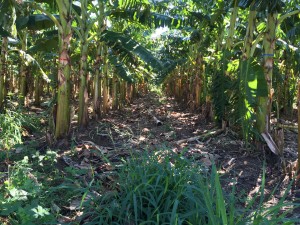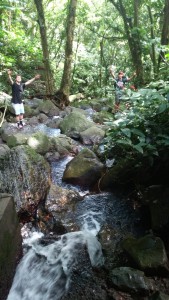Puerto Rico has been a bit different than I expected. I knew coming in that the weather would be nice and tropical, and that the food would be a bit similar to latino foods. I also knew that agriculture would play a far smaller role in the everyday lives of most rural people than it does in Illinois, seeing as our home state has far more land that is viable for agricultural use when compared to Puerto Rico. What I didn’t expect was how heavily they use the plantain in their everyday lives. I had heard it was a staple, but I didn’t realize just how many ways it was possible to use the plantain. I had assumed it was like a banana, sweet and a bit pulpy, but it’s far easier to use them everyday when compared with bananas. For example, there are mofongos and tostones everywhere, and plantains are sometimes even shredded and used like hash browns of sorts in different kinds of meals. Because of the heavy demand for plantains, there are farms with substantial output potential. The farm we visited was far more vast than I had anticipated and had huge sections dedicated to both mangos and plantains. The processing plant we visited while at the farm was also quite sizable, and it was very interesting to see the processes that take place before the shipping of the fruits we eat. I hadn’t really thought about it in depth, so I expected the farmers to be picking fruits when they ripened, instead of weeks in advance, though that makes sense once considering the time it takes to ship the fruits.
Another thing that surprised me was the diversity of ecosystems that the island contains. During our multiple drives across practically the entire island, we saw multiple different ecosystems. When we first arrived, we got to visit El Yunque, one of the largest rainforests on the island, which was quite sizable, and had some impressive vertical drops, all in a tropical, densely forested area. It also had a couple hidden waterfalls deep in the jungle, and though there were some areas which were a bit touristy/well known, there were places very close to them where you couldn’t tell that people had been there at all. One picture I have was taken right next to La Mina Falls, one of the most visited locations in the entire rainforest, and yet the ecosystem looks practically untouched. An ecosystem we saw a good amount of but never interacted with was the more arid, desert-like area. There were huge swaths of desert area clearly visible as we drove across Puerto Rico, and it was clear that the land wasn’t particularly useful, as we saw fewer and fewer towns as we gradually transitioned from rainy to dry areas. Puerto Rico has also been significantly more mountainous than I expected. I knew it wasn’t going to be as flat as Illinois, seeing as our entire state has 10 hills, give or take a couple, but we have seen a good amount more mountains than I anticipated, and we ended up staying in an ecolodge near the top of one. They also take advantage of all the farmable land they have, as there was a coffee plantation that we visited up in the mountains, and we were also told that there were some plantain plantations in the mountains as well. It was interesting to see, considering that in Illinois, if land is remotely rocky or steep, practically nobody considers it farmable, from my experiences. The accessibility of the coral reefs off the island was also very cool, as the trip from our hotel to the coral reefs was under an hour, excluding the wait for our catamaran to disembark, and in Illinois, depending where you are, the trip from a mountain/hill to any substantial source of water is quite sizeable, and it’s difficult to find mountains to begin with. 


